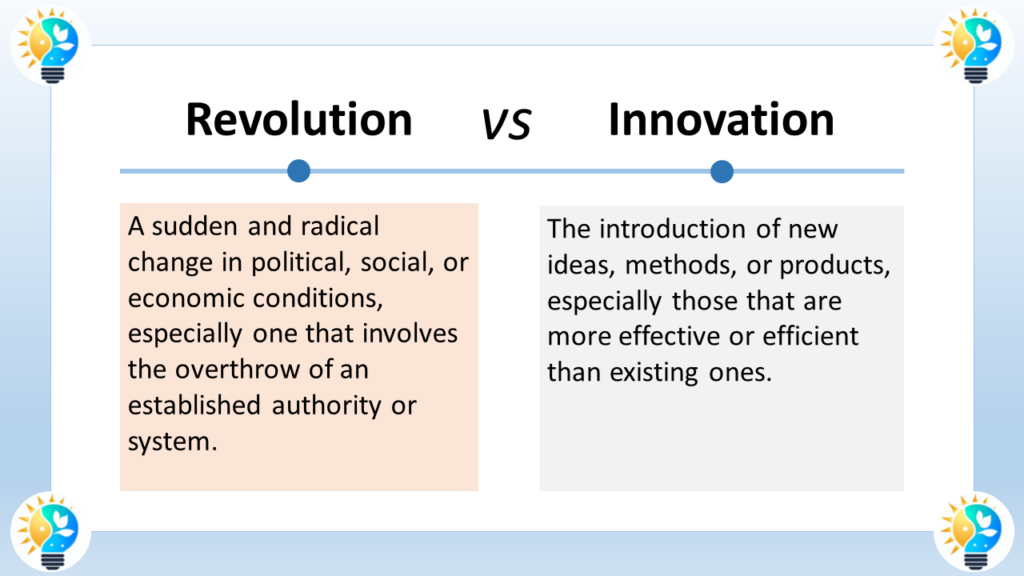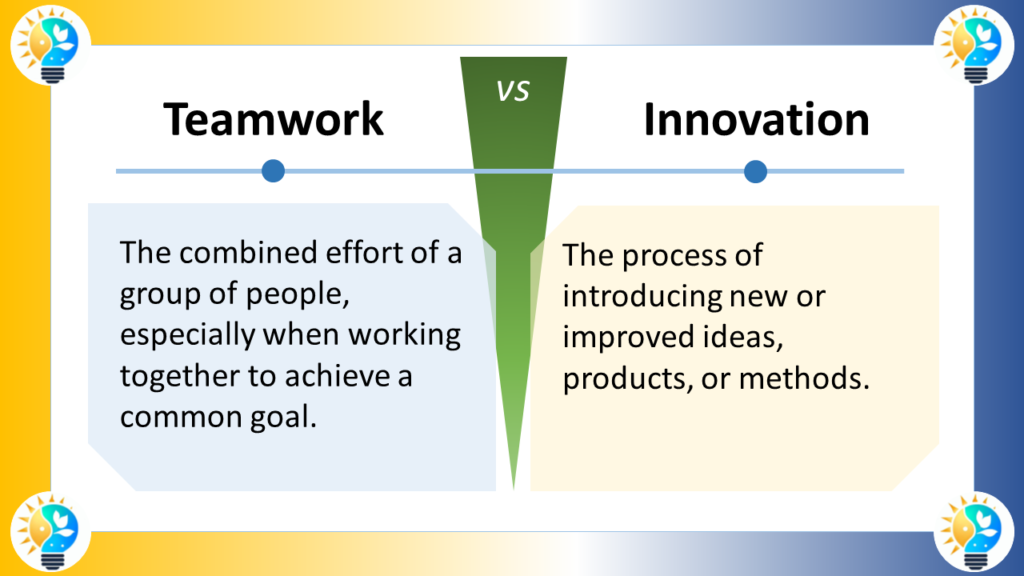
Revolution signifies a transformative upheaval, leading to radical shifts in societal, political, or economic structures, often challenging established norms or systems.
Innovation embodies a continuous process of introducing new ideas or methodologies.
It may contribute to revolutionary changes over time, driving evolution and progress in societies or industries through the adoption of innovative practices or technologies.
Definitions
Innovation
Innovation refers to the process of creating new ideas, products, services, or processes that add value and improve upon existing solutions. It involves thinking outside the box, challenging conventional wisdom, and embracing risk to drive meaningful change. Innovation is essential for organizations to remain relevant and maintain a competitive edge in their respective industries. It can take various forms, such as incremental innovation (improving existing products or processes), disruptive innovation (introducing entirely new products, services, or business models that disrupt the market), and radical innovation (revolutionizing an industry through groundbreaking technologies or concepts).
Revolution
Revolution, in the context of business and technology, can be defined as a sudden, radical, or transformative change that disrupts an industry or market. Revolutionary developments often involve the introduction of groundbreaking new technologies, business models, or concepts that fundamentally alter the way an industry operates. Such changes can have far-reaching implications, creating new opportunities and challenges for organizations and reshaping the competitive landscape. Revolutions can be driven by various factors, including technological advancements, shifts in consumer preferences, regulatory changes, or the emergence of disruptive innovations.
More Synonyms on innovation, innovate and innovative
Innovation Terms

Innovation is considered as a driving force in progress.
It includes the introduction of novel ideas, methods, or products that bring positive change and advancement.
For more information about innovations, check our glossary

Innovation is considered as a driving force in progress.
It includes the introduction of novel ideas, methods, or products that bring positive change and advancement.
For more information about innovations, check our glossary
Innovation: The Engine of Progress
Innovation, as previously defined, refers to the process of creating new ideas, products, services, or processes that add value and improve upon existing solutions. It involves thinking outside the box, challenging conventional wisdom, and embracing risk to drive meaningful change. Innovation is essential for organizations to remain relevant and maintain a competitive edge in their respective industries.
Revolution: Disrupting the Status Quo
Revolution, in the context of business and technology, can be defined as a sudden, radical, or transformative change that disrupts an industry or market. Revolutionary developments often involve the introduction of groundbreaking new technologies, business models, or concepts that fundamentally alter the way an industry operates. Such changes can have far-reaching implications, creating new opportunities and challenges for organizations and reshaping the competitive landscape.
The Innovation-Revolution Continuum
While innovation and revolution represent different degrees of change, they exist on a continuum, with incremental innovation at one end and radical revolution at the other. This continuum helps illustrate the relationship between the two concepts:
- Incremental innovation: Small improvements or enhancements to existing products, services, or processes. These changes are typically evolutionary, building upon past successes and incrementally increasing value.
- Disruptive innovation: The introduction of new products, services, or business models that create new market segments and ultimately displace established competitors. Disruptive innovations can have significant, albeit usually gradual, impacts on an industry.
- Radical innovation: The development and implementation of groundbreaking technologies, concepts, or business models that fundamentally transform an industry or create entirely new ones. Radical innovations often lead to revolutionary changes, as they disrupt the status quo and redefine the rules of the game.
Why Innovation and Revolution Are Interconnected?
Although innovation and revolution serve different purposes and result in varying degrees of change, they are deeply interconnected and rely on one another to drive transformative progress:
- Incremental innovation paves the way for revolution: By continuously improving existing products, services, and processes, organizations lay the groundwork for more significant, revolutionary advancements. Incremental innovations can help identify unmet needs, refine technologies, and build the necessary infrastructure for radical change.
- Revolution inspires further innovation: Revolutionary developments can create new opportunities and challenges, spurring additional rounds of innovation. As organizations adapt to and leverage revolutionary changes, they often develop new products, services, or processes that further enhance their competitive position and contribute to industry growth.
- Balancing short-term gains and long-term vision: Successful organizations must strike a balance between focusing on immediate needs and pursuing a long-term vision. Innovation and revolution help achieve this balance by enabling companies to address current challenges while simultaneously preparing for future disruptions and opportunities.
Difference between revolutionary and innovative can be summarized as follows:
- Revolutionary Innovation: This type of innovation involves radical and discontinuous leaps to completely novel offerings, opening up new business and growth trajectories. It aims at creating the world as it could be, addressing a future that doesn't exist yet but will emerge through the innovation itself. Revolutionary innovation is closely connected with high uncertainty and visionary foresight. It is generational and requires a visionary approach to revolutionize industries, products, or processes.
- Evolutionary Innovation: In contrast, evolutionary innovation focuses on continuous and incremental improvements to existing products, processes, systems, and structures. It seeks to optimize the world as it is by making gradual changes that are more predictable and easier to fix if they do not work. Evolutionary innovation relies on customer insight capabilities and aims at adapting to today's customers.
In essence, while revolutionary innovation brings about sudden and complete changes by envisioning what could be in the future, evolutionary innovation focuses on gradual progress and continuous improvement based on existing foundations to meet current needs. Both types of innovation play crucial roles in the development of technology, industry, and business, with revolutionary innovations often paving the way for subsequent incremental improvements.
Innovative Terms

Innovation is considered as a driving force in progress.
It includes the introduction of novel ideas, methods, or products that bring positive change and advancement.
For more information about innovations, check our glossary
Case Study: The Automotive Industry – From Horse-Drawn Carriages to Electric Vehicles
The automotive industry provides a compelling example of the relationship between innovation and revolution. Over the past century, the industry has undergone numerous incremental innovations, such as the introduction of assembly lines, safety features, and fuel-efficient engines. These advancements have collectively contributed to the development of modern automobiles and the growth of the global auto industry.
More recently, the industry has experienced a wave of revolutionary changes, driven by the emergence of electric vehicles (EVs), autonomous driving technologies, and shared mobility services. Companies like Tesla, Waymo, and Uber have disrupted the traditional auto industry, forcing established players to adapt and innovate in response.
This ongoing cycle of innovation and revolution has not only transformed the automotive industry but also created new opportunities for growth and development, as well as challenges that organizations must address to remain competitive in the face of rapid change.
Conclusion
In conclusion, the relationship between innovation and revolution is critical for driving transformative change and ensuring long-term success. By recognizing the interplay between these two concepts and leveraging their complementary strengths, organizations can strike a balance between short-term gains and long-term vision, ultimately positioning themselves to thrive in an ever-evolving business landscape.
Articles and Blogs:
- Fedcap Group - Innovation: Revolution, Evolution, or a Combination?
- Tim Kastelle's Blog - Evolutionary and Revolutionary Innovation
- Bplans - What is Innovation: Evolutionary or Revolutionary?
- IdeaNote Blog - Types of Innovation
- LinkedIn - Product Innovation: How to Create Revolution vs. Evolution
Books:
- Managing Innovation: Integrating Technological, Market and Organizational Change
- The Innovator's Dilemma: When New Technologies Cause Great Firms to Fail
- What Is Disruptive Innovation?
- Disruptive Innovation: In Need of Better Theory
- Diffusion of Innovations (5th ed.)
Company Reports:

